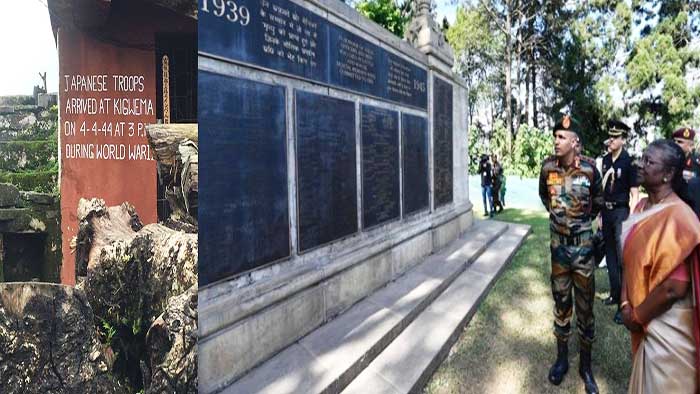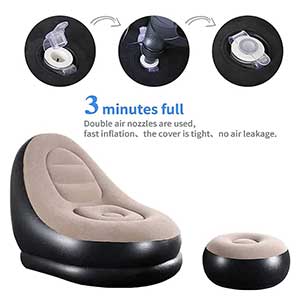Kigwema village in Nagalands Kohima district still carries the legacy of the Second World War (1939-45) as Japanese soldiers were stationed in the mountainous village during the war and fought the Battle of Kohima.
The British and Indian troops fought against the Japanese invaders in the 80-day-long Battle of Kohima which started on April 4, 1944.
The Japanese were defeated, forcing them to retreat.
President Droupadi Murmu visited the popular Kigwema village on November 3 last year.
After visiting the village, Murmu had said she would take back with her good memories of the famous Naga village, where Mount Japfu, the second highest peak in Nagaland, is situated.
Nagaland Chief Minister Neiphiu Rio said that it is one of the largest villages of Nagaland with a population of 7,562.
The Chief Minister said that the village has a virgin forest with steep hills but it has a gentle slope with fertile land suitable for cultivating paddy, vegetables and fruits.
Kigwema Village Council Chairman Balie Kire said that the village was partnering with the Central government and state government in various initiatives, policies, development work and other schemes.
Balie Kire added that the village is co-existing with the Army and para-military forces stationed at Zakhama Military Station.
According to Dr Samudra Gupta Kashyap, a Guwahati-based author and journalist, Ruzazho is another small village which a section of the local people say was liberated from the British by the Azad Hind Fauj or the Indian National Army (INA) in April 1944.
The Azad Hind government reportedly 'administered' the village for a few months thereafter, with local historians claiming that Netaji Subhas Chandra Bose had visited the Naga Hills, had spent a few days at Ruzazho, and had also appointed a local youth Vesuyi Swuro as a dobashi (interpreter), Kashyap told IANS.
The Battle of Kohima was one of the fiercest battles of WW-II, in which British and Indian troops fought against the Japanese.
The Japanese were defeated, marking the beginning of the Allied forces' push into what was then Burma and is now Myanmar.
One of the most decisive battles fought on the eastern front in the Second World War, the Battle of Kohima, has been largely forgotten by most Indians.
In 1944, during the height of the war, under "Operation U Go", the Japanese commander in the region Lieutenant Gen Renya Mutuguchi, planned an incursion into India via Burma.
Assistant Professor Pfutsero of the Government College in Nagaland in his paper titled 'INA and Northeast India', said that Lieutenant Gen Mutuguchi along with Subhas Chandra Bose hoped to bring about a complete collapse of the British Raj in India.
The plan was to attack the northeast of India through Burma.
The Japanese forces intended to attack the British garrison in Kohima after which they would take Assam and then march on to Delhi, but the British and Indian forces fought heroically and thwarted the ambitious plans of Japan.
In March 1944, the Japanese came in through the dense jungles of the northeast region from Burma into India.
They attacked Imphal first, catching the British by surprise. After this, they eyed Kohima and the garrison stationed there which was a relatively obscure barracks because this part of the region was not key to British plans.
With around 2500 personnel, the British and Indian contingent battled with the 12,000 to 15,000 Japanese soldiers comprising three divisions - 15th, 31st and 33rd.
The British troops held on to the Japanese strategic positions and troubled them with their experienced artillery fire.
The Japanese were also worried by the lack of adequate supplies. They had brought along with them about 5,000 oxen to be slaughtered for food, but most of the animals died on the way.
The bungalow and the tennis court of the Deputy Commissioner of Kohima were witness to bloody battles.
Many engaged in hand-to-hand combat. The number of people who perished was in the thousands and many others got sick because of the stench of rotting corpses.
Supplies were low on both sides but the soldiers battled on steadfastly.
British reinforcements arrived in Dimapur to relieve the forces at Kohima. The Japanese realised that their position was precarious as they were extremely low on supplies forcing them to start to fall back.
The Indian and British troops lost about 4,000 men while the Japanese lost 5000 to 7000 men in the Battle of Kohima which is often referred to as the "Stalingrad of the East".
The British National Army Museum voted this battle as "Britain's Greatest Battle".
Today, in the place where the tennis court of the Deputy Commissioner was, there is a war cemetery for the Allied dead.
It has the famous Kohima Epitaph which reads "When you go home, tell them of us and say for your tomorrow, we gave our today."
The Battle of Kohima turned the tide of the war in the eastern theatre, forcing the Japanese to retreat.




Mistake that benefits no one: World leaders react to Trump's 'reciprocal tariffs'
As US President Donald Trump signed an executive order on the so-called "reciprocal tariffs," the world reacted sharply against the decision, with some calling it a "mistake that benefits no one" while others called it a violation of Washington's obligations under the World Trade Organization (WTO).
Indian pharmaceutical exports get reprieve from Trump’s reciprocal tariffs
Because of the importance of India’s pharmaceuticals to US healthcare, those exports will get a reprieve from President Donald Trump’s reciprocal tariffs, according to the White House.
India stands less impacted by Trump tariffs than global peers: Industry
As US President Donald Trump announced reciprocal tariffs on dozens of countries, including India, industry experts said on Thursday that it appears India's export competitiveness to the US market stands far less impacted on a relative basis compared to global peers.
IAF pilot killed, another critical as Jaguar fighter jet crashes in Gujarat
An Indian Air Force (IAF) pilot lost his life, while another sustained critical injuries after their two-seater Jaguar fighter jet crashed near Gujarat's Jamnagar Airfield, the IAF confirmed on Thursday.
PM Modi emplanes for Thailand; to attend BIMSTEC summit
Prime Minister Narendra Modi on Thursday emplaned for Thailand on a state visit to attend the 6th BIMSTEC Summit, with his visit also set to bolster bilateral relations between New Delhi and Bangkok.
Tripura CM stresses promoting NE states' potential to attract investment
Tripura Chief Minister Manik Saha on Wednesday said that the development of the communication process and system has generated a lot of investment potential, and therefore, more emphasis should be placed on promotion to attract investors in all the northeastern states.
Tripura has 94,723 Lakhpati Didis; 93,425 women to get similar status soon: Minister
Among the 4,75,582 Self Help Group (SHGs) members in Tripura, 94,723 women emerged as ‘Lakhpati Didis’ through their engagement in various enterprising units and 93,425 more women would be ‘Lakhpati Didis’ soon, Social Welfare and Labour Minister Tinku Roy said.
Bhavan’s Little Learners celebrate annual programme
The Bhavan’s Little Learners, Bordowali celebrated annual programme and organised prize distribution ceremony here at Agartala Rabindra Satabarshiki Bhavan on Wednesday.